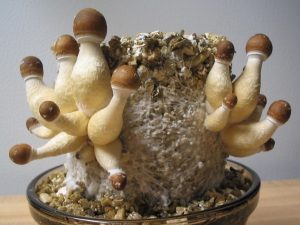The consumption of mushrooms probably occurred during prehistory, in the hunting and gathering period. Unlike plants, mushrooms could not be cultivated at first and were collected for a long period of time. Even today, relatively few species of mushrooms can be cultivated compared to the number of edible species. Mushrooms were thought to be special and supernatural in origin – 4600 years ago, the Egyptians believed mushrooms to be plants of immortality; the Pharaohs decreed that only they could eat mushrooms. The Romans thought mushrooms were the food of the gods. Many people collect mushrooms for the purpose of consumption, but lots of myths and false concepts still survive today.
The Chinese and Japanese have utilised mushrooms for medicinal purposes for thousands of years. Lentinus edodes, Shiitake, was originally cultured in China about 800 years ago. Research in Japan claims that this mushroom has medicinal use – Shiitake was combined with AIDs drugs to boost immune response, combat chronic fatigue and induce antibody formation to Hepatitis B; it also stimulated antitumor activity. Auricularia polytricha, “ear fungus”, was first cultivated in ancient China around 300 to 200 B.C. This mushroom is now cultivated in many South Pacific countries. Flammulina velutipes, Enokitake, has been cultivated for several centuries; this small delicate mushroom was cultivated on sawdust.
Different cultures cultivated different species – cultivation of mushrooms in Western cultures was first recorded in Paris, France, around 1650. Agaricus bisporus, the quintessential “shop mushroom”, was first observed growing in melon crop compost. This mushroom was cultivated in open fields for 160 years and then moved underground into caves, excavated tunnels or quarries – this form of cultivation is still used in France today. From France, the gardeners of England found Agaricus bisporus a very easy crop to grow which required little labour, investment and space. By 1865, the United States began mushroom cultivation. There are two widely known genetic variants of Agaricus bisporus – these are Portobello and Crimini.
Truffles have been collected as far back as 1600 B.C. As recently as 1903, truffles were believed to be a product of oak trees. Until after World War II, the only means of obtaining truffles was collecting them in the wild. These subterranean mushrooms cannot be “cultivated” in the usual sense because they form a mycorrhizal (symbiotic) relationship with the roots of trees. The two most popular species “cultivated” are Tuber melanosporum, the Perigord Truffle, and Tuber magnatum, the White Truffle (both are not British). The idea of “growing” truffles began in 1972, in an oak plantation – this required up to 10 years or more before the first truffles were harvested. Numerous efforts have been made to grow oaks outside of their native area that mostly failed, until 1987, when some New Zealanders attempted to grow truffles – this was successful and it only took 5 years to harvest the mushrooms.
Numerous attempts have been made to cultivate morels but this mushroom has never been successfully cultivated commercially. Although there are several species of edible morels, Morchella esculenta is the most sought after; during 1980 in the United States, Ron Ower grew the first Morchella esculenta, but his yield was very low. Several years later, Gary Mills of Neogene Corporation, collaborated with Ron and seemed to successfully produce a high yield method, but it only worked in Michigan; attempts to use this method elsewhere failed.
Thanks to Clifford Davy of Forest Foragers.

